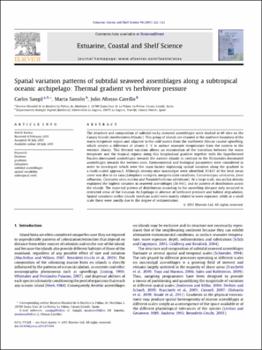Spatial variation patterns of subtidal seaweed assemblages along a subtropical oceanic archipelago: thermal gradient vs herbivore pressure.
Fecha
2011Resumen
The structure and composition of subtidal rocky seaweed assemblages were studied at 69 sites on the
Canary Islands (northeastern Atlantic). This group of islands are situated at the southern boundary of the
warm temperate region and adjacent to the cold waters from the northwest African coastal upwelling,
which creates a difference of almost 2 C in surface seawater temperature from the eastern to the
western islands. This thermal variation allows an examination of the transition between the warm
temperate and the tropical regions along this longitudinal gradient together with the hypothesised
Fucales-dominated assemblages towards the eastern islands in contrast to the Dictyotales-dominated
assemblages towards the western ones. Environmental and biological parameters were considered in
order to investigate which were the main factors explaining spatial variation along the gradient in
a multi-scaled approach. Although seventy-nine macroalgae were identified, 87.63% of the total mean
cover was due to six taxa (Lobophora variegata, nongeniculate corallines, Canistrocarpus cervicornis, Jania
adhaerens, Cystoseira abies-marina and Pseudolithoderma adriaticum). At a large scale, sea urchin density
explained the highest variation in seaweed assemblages (26.94%), and its pattern of distribution across
the islands. The expected pattern of distribution according to the upwelling distance only occurred in
restricted areas of the Canarian Archipelago in absence of herbivore pressure and habitat degradation.
Spatial variations within islands (medium scale) were mainly related to wave exposure, while at a small
scale these were mostly due to the degree of sedimentation.






